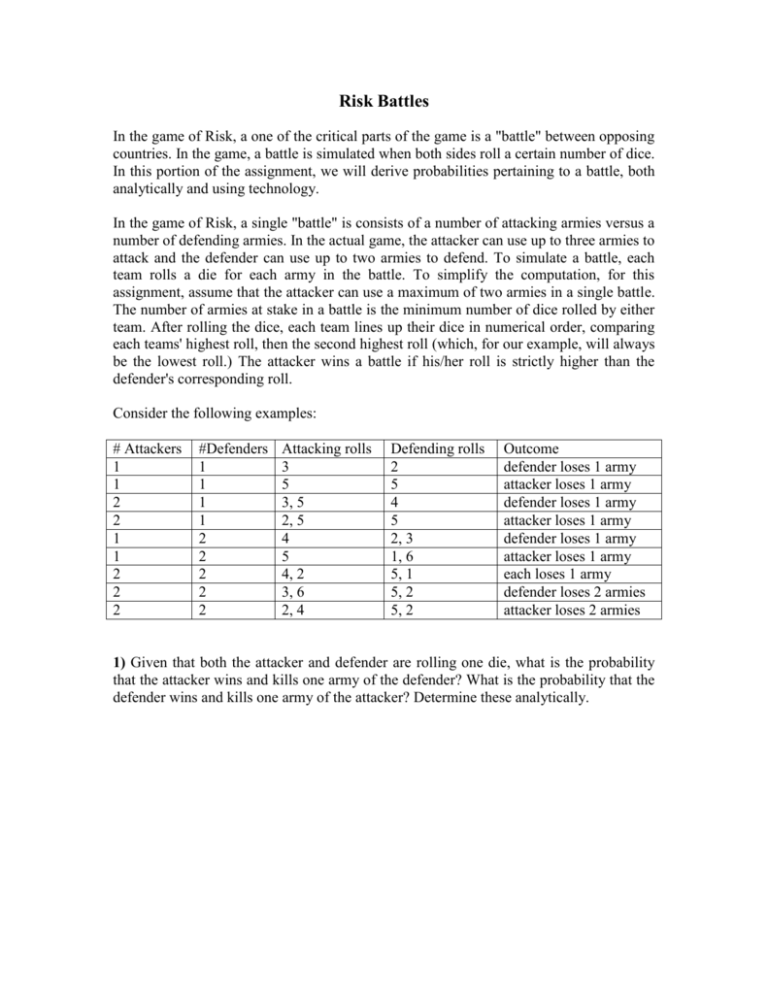(Portfolio Assignment 3: Mathematical Modelling)
advertisement

Risk Battles In the game of Risk, a one of the critical parts of the game is a "battle" between opposing countries. In the game, a battle is simulated when both sides roll a certain number of dice. In this portion of the assignment, we will derive probabilities pertaining to a battle, both analytically and using technology. In the game of Risk, a single "battle" is consists of a number of attacking armies versus a number of defending armies. In the actual game, the attacker can use up to three armies to attack and the defender can use up to two armies to defend. To simulate a battle, each team rolls a die for each army in the battle. To simplify the computation, for this assignment, assume that the attacker can use a maximum of two armies in a single battle. The number of armies at stake in a battle is the minimum number of dice rolled by either team. After rolling the dice, each team lines up their dice in numerical order, comparing each teams' highest roll, then the second highest roll (which, for our example, will always be the lowest roll.) The attacker wins a battle if his/her roll is strictly higher than the defender's corresponding roll. Consider the following examples: # Attackers 1 1 2 2 1 1 2 2 2 #Defenders 1 1 1 1 2 2 2 2 2 Attacking rolls 3 5 3, 5 2, 5 4 5 4, 2 3, 6 2, 4 Defending rolls 2 5 4 5 2, 3 1, 6 5, 1 5, 2 5, 2 Outcome defender loses 1 army attacker loses 1 army defender loses 1 army attacker loses 1 army defender loses 1 army attacker loses 1 army each loses 1 army defender loses 2 armies attacker loses 2 armies 1) Given that both the attacker and defender are rolling one die, what is the probability that the attacker wins and kills one army of the defender? What is the probability that the defender wins and kills one army of the attacker? Determine these analytically. 2) Now work out the probabilities analytically for the rest of the possible events (except where both sides use two dice). A chart is given for you below: Number of attackers 1 1 1 1 2 2 Number of defenders 1 1 2 2 1 1 Event Defender loses 1 Attacker loses 1 Defender loses 1 Attacker loses 1 Defender loses 1 Attacker loses 1 Probability Note: This may become tedious, but look to reduce your work by using counting arguments. Furthermore, don't forget the sum of the probabilities of all possible outcomes of a particular situation always adds to 1. 3) Using technology (either a writing a computer program, or writing a program for your calculator), determine the corresponding probabilities for the three possible outcomes of battles with 2 attackers and 2 defenders. Number of attackers 2 2 2 Number of defenders 2 2 2 Event Defender loses 2 Each loses 1 Attacker loses 2 Probability Also, verify all of your results you derived in question 2 when a total of three dice are rolled using a similar program to the one you wrote for this part. Now, we will analyze strategies in the game of Risk using Markov chains and probability. Markov chains can be used to model systems that contain a certain number of states where during discrete time increments, the system moves from one state to another. Each movement in such a system is governed by conditional probabilities. For example, given that you are in state 3, in may be known that the probability of moving to state 6 on the next move is 1/4. In such a system, if we wanted to calculate the probability of being in a particular state sk at time step t, letting we could simply compute the following sum: n P(( s i 1 k , t ) | ( si , t 1)) P(( si , t 1)) In English, what this is saying is that the probability of ending up in state k at time t can be calculated by taking the probability you'll be in state i at time step t-1 and multiplying that by the probability you'll move to state k on the following time step. You do this for each possible state i and add up all of these disjoint probabilities. Given a system with n states, we can create a 2-dimesional square matrix (called a transition matrix) of size nxn, which contains all the possible conditional probabilities necessary to make calculations about the system. In particular, in this matrix, the entry in row i, column j will be the probability of moving to state i from state j. Consider the following example: Let's say that you have a game board with five squares, a, b, c, d and e. Here are probabilities of movement in between squares on the game board: p(going to b | at a) = 1/2 p(going to c | at a) = 1/2 p(going to a | at b) = 1/2 p(going to b | at b) = 1/3 p(going to d | at b) = 1/6 p(going to b | at c) = 1/2 p(going to d | at c) = 1/3 p(going to e | at c) = 1/6 Assume that once you move to square d, you win, and if you move to square e, you lose. (Thus, the probability from moving from square d to square d is 1, and the probability of moving from square e to square e is 1.) Here is the transition matrix for this game: 0 1/2 0 0 0 1/2 1/3 1/4 0 0 1/2 0 0 0 0 0 1/6 1/4 1 0 0 0 1/2 0 1 Here is the square of this matrix 1/4 1/6 1/8 0 0 7/24 13/36 1/12 0 0 0 1/4 0 0 0 5/24 2/9 7/24 1 0 1/4 0 1/2 0 1 Given this matrix above, the entry in row i, column j represents the probability of moving from square i to square j in 2 moves. In general, if you take a transition matrix to the nth power, the entry in row i, column j represents the probability of moving from square i to square j in n moves. Typically, there's a "steady state" answer that the exponentiation of a transition matrix approaches as n grows. In order to utilize Markov chains to analyze Risk battles, we will have to determine the size of our transition matrix and the meaning of each entry. Let A be the number of attacking armies and D be the number of defending armies. Our goal is to determine the probability of the attacker winning the overall battle. (Subtracting this value from one will give us the probability of the defender winning the battle.) We will have AD + A + D states for our transition matrix. Each state will be denoted with an ordered pair (x,y), where x is the current number of attacking armies and y is the current number of defending armies. In our rules, we will assume that if both x and y are at least 2, then a single battle will be fought between 2 attacking and 2 defending armies. In all other situations, there will either be one army vs. one or two armies, based upon the maximum availability of armies for each side. Here is the list of the first AD different states of our battle: (1, 1), (1, 2), ... , (1, D), (2, 1), (2, 2), ... , (2, D), ... , ... (A, 1), (A, 2), (A, D) These are non-terminal states because eventually the battle will terminate with one of the two sides with exactly 0 armies left. The following A+D states are terminal states: (0, 1), (0, 2), ... , (0, D), (1, 0), (2, 0), ... , (A, 0) Our transition matrix will have a row and column for each of these states. For example, for A=3 and D=2 (A battle between 3 attacking armies and 2 defending ones), we have: (1,1) (1,1) (1,2) (2,1) (2,2) (3,1) (3,2) (0,1) (0,2) (1,0) (2,0) (3,0) (1,2) (2,1) (2,2) (3,1) (3,2) (0,1) C (0,2) (1,0) (2,0) (3,0) B A D E F where the entry in row (a,b) and column (c,d) stands for the probability of starting a single battle with a attackers and b defenders and ending the battle with c attackers and d defenders. As an example, the entry A would be the probability that given that you start with 3 attackers and 2 defenders that you end the single battle with 2 attackers and 1 defender. This is exactly the probability of each side losing one army in a battle between 2 attackers and 2 defenders. The entry B is the probability that an attacker with 2 armies wins against a defender with 1 army. Finally, entry C is the probability that the defender wins in a battle between 1 attacking army and 1 defending army. 4) Given that we take this matrix and exponentiate it to a power that is high enough, what should the sum of the values D, E and F represent? What power is sufficient (high enough) for this particular case? 5) Fill in the values for this entire transition matrix. (Note: many of these values will be 0, do not be alarmed by this.) 6) Determine the probability of an attacker with 3 armies defeating a defender with 2 armies. (Note: I am not asking for a larger result because of the tedium of entering a large matrix into your calculator. Even for this very small problem, an 11x11 matrix with 121 entries has to be exponentiated.) 7) In the regular game of Risk, in a single battle, an attacker is allowed to attack with three armies, while the defender can defend with at most two armies. (In this situation, you roll 3 and 2 dice, respectively.) Basically, you simply use the two best rolls of the attacker to determine the outcome. Determine the probability of each of the following outcomes in a single battle of 3 attackers vs. 2 defenders: Defender loses 2 armies, each team loses 1 army, and the Attacker loses 2 armies. 8) Now, using the real probabilities for the game of Risk, augment this assignment and make calculations for the probabilities of successful sets of attacks between countries that have more than 3 armies vs. 2 armies. (This is open-ended intentionally. I want you to pick the scope of what you calculate.)




